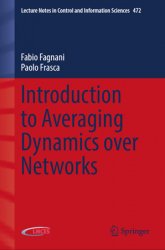
Автор: Fabio Fagnani, Paolo Frasca
Название: Introduction to Averaging Dynamics over Networks
Издательство: Springer
Год: 2017
ISBN: 9783319680217
Серия: Lecture Notes in Control and Information Sciences (Book 472)
Язык: English
Формат: pdf
Размер: 5 mb
Страниц: 135
Starting from the classical evolution of the powers of a fixed stochastic matrix, the text then considers more general evolutions of products of a sequence of stochastic matrices, either deterministic or randomized. The theory needed for a full understanding of the models is constructed without assuming any knowledge of Markov chains or Perron–Frobenius theory. Jointly with their analysis of the convergence of averaging dynamics, theauthors derive the properties of stochastic matrices. These properties are related to the topological structure of the associated graph, which, in the book’s perspective, represents the communication between agents. Special attention is paid to how these properties scale as the network grows in size.
Finally, the understanding of stochastic matrices is applied to the study of other problems in multi-agent coordination: averaging with stubborn agents and estimation from relative measurements. The dynamics described in the book find application in the study of opinion dynamics in social networks, of information fusion in sensor networks, and of the collective motion of animal groups and teams of unmanned vehicles. Introduction to Averaging Dynamics over Networks will be of material interest to researchers in systems and control studying coordinated or distributed control, networked systems or multiagent systems and to graduate students pursuing courses in these areas.
1 Graph Theory
1.1 Basic Definitions and Examples
1.2 Paths and Connectivity
1.3 Periodicity
1.4 Matrices and Eigenvalues
1.5 Examples of Graphs
1.5.1 Circulant Graphs
1.5.2 Product Graphs
1.5.3 Cayley Graphs
1.5.4 De Bruijn Graphs
Exercises
Bibliographical Notes
References
2 Averaging in Time-Invariant Networks
2.1 Rendezvous and Consensus
2.2 Averaging on Symmetric Regular Graphs
2.3 Stochastic Matrices and Averaging
2.4 Convergence Rate and Eigenvalues
2.5 Consensus Point
2.6 Stochastic Matrices Adapted to a Graph
2.7 Convergence Rate: Examples
2.8 Reversible Matrices
Exercises
Bibliographical Notes
References
3 Averaging in Time-Varying Networks
3.1 Time-Varying Updates: Uniform Connectivity
3.2 Time-Varying Updates: Cut-Balanced Interactions
3.3 Randomized Updates
Exercises
Bibliographical Notes
References
4 Performance and Robustness of Averaging Algorithms
4.1 A Deeper Analysis of the Convergence to Consensus
4.2 Rendezvous and Linear-Quadratic Control
4.3 Robustness Against Noise
4.4 Robustness Against Quantization Errors
4.5 Distributed Inference
Exercises
Bibliographical Notes
References
5 Averaging with Exogenous Inputs and Electrical Networks
5.1 Electrical Networks and Harmonic Functions
5.2 Effective Resistance in Electrical Networks
5.3 Averaging Dynamics with Stubborn Agents
5.4 Estimation from Relative Measurements
Exercises
Bibliographical Notes
References
Index
[urlhttp://turbobit.net/3arynvbsfux3.html=]Turbobit[/url] || 2bay |